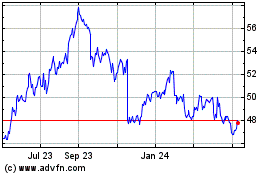By Angus Loten
Cisco Systems Inc. is turning to smart software in a bid to ward
off a number of fast-growing rivals challenging its lead in the
enterprise-collaboration market, which helps employees within an
organization communicate with chat, videoconferencing and other
tools.
Amy Chang, senior vice president of Cisco's collaboration
technology group, said a new generation of digital capabilities is
transforming enterprise collaboration, citing the impact of cloud
computing and machine learning, among other emerging tools.
That is forcing the more than 30-year-old tech company to think
like "a giant startup," Ms. Chang said: "We have to behave that way
or we will not be in the market a decade from now," she told CIO
Journal.
A former global head of product at Google Analytics, Ms. Chang
was tapped to lead Cisco's collaboration business last May, when it
acquired her relationship-intelligence venture, Accompany, for $270
million.
At Accompany, Ms. Chang and a small team of former Google
engineers and developers built algorithms with machine-learning
capabilities to automate the process of creating information-rich
personal profiles by scouring countless public online sources.
She is now putting those capabilities to work at Cisco, in a bid
to upgrade its enterprise collaboration tool, known as Webex. That
includes an initiative in the past year to couple
facial-recognition technology with auto-generated personal
profiles, enabling users to identify meeting participants -- from
present job titles, to past work experience, expertise or off-duty
hobbies, like golfing, bowling or line dancing.
"I think of this as an enterprise LinkedIn," she said, "It lets
me know who I am talking to and what is their expertise."
Webex currently boasts 130 million meeting attendees every
month, and more than 360 million meetings hosted each year,
including 95% of Fortune 500 firms, the company said.
The global market for enterprise collaboration is estimated to
have grown 11.8% last year to $2.4 billion, and is on pace to reach
$3.2 billion by 2021, according to International Data Corp.
Wayne Kurtzman, an IDC research director for social and
collaboration, said market growth is now being fueled by office
workers and other professionals expecting the same capabilities in
the workplace that they get on social media when sharing photos,
buying products or videoconferencing with friends and family on
personal mobile devices.
The focus on boosting Webex with new artificial
intelligence-powered services is part of a broader strategy at
Cisco to build revenue on recurring software sales, and move away
from one-time hardware sales.
There are signs the strategy is working. Cisco in February
reported a fiscal second-quarter profit of $2.82 billion, with
revenue rising 4.7% to $12.45 billion. While revenue from its core
business of selling switches, routers and other networking
equipment to companies rose 6% to $7.13 billion, its applications
business, which includes videoconferencing and other products, grew
24% to $1.47 billion.
Chuck Robbins, the company's chairman and chief executive, said
the gains were the result of a strategy to "aggressively
transitioning to a software model and accelerating our pace of
innovation."
Some analysts are less convinced, calling Cisco's software push
a case of too little, too late: "One of Cisco's challenges is that
Slack and Microsoft (with Teams) are redefining enterprise
messaging faster than Cisco has been able to respond with Webex,"
said Larry Cannell, research director at Gartner Inc. for technical
professionals, collaboration and content strategies service.
Teams, Microsoft Corp.'s two-year-old collaboration tool, has
benefited from the tech giant's strength in both the cloud and
desktop software markets, according to tech industry analysts.
Microsoft last month said more than 500,000 organizations are
using the tool for workplace chat, messaging and meetings,
including 91 Fortune 100 companies. It recently rolled out added
features, including customized backgrounds for videoconferencing,
live captions for meetings and a broadcast feature for up to 10,000
viewers.
Cisco's other fast-growing rivals in the collaboration market
include Slack Technologies Inc., which launched in 2013. In the
past year, Slack has grown 50% to 10 million daily active users,
including 65 Fortune 100 firms and 85,000 paying customers,
offering meetings and messaging tools, while position itself as a
central hub with a directory of more than 1,500 apps, the company
says.
Facebook Inc.'s Workplace, another competitor that entered the
collaboration market in late 2016, currently has some two million
paid users, including more than 150 companies with over 10,000
users each, the company said.
As for adding facial recognition to Cisco's Webex, Gartner's Mr.
Cannell sees limited value.
"Using facial recognition is a video-centric approach that
hardly applies to collaborative scenarios where participants
already know each other," Mr. Cannell said. "So, no, I don't think
facial recognition will necessarily help Cisco compete with Slack
and Microsoft Teams."
Ms. Chang said Webex may not have impressive growth rates, but
only because its total number of users is so large. As a result,
she said, adding a few million new users appears only as a small
percentage growth.
"Last year we grew an entire Slack in 10 months," Ms. Chang
said.
Write to Angus Loten at angus.loten@wsj.com
(END) Dow Jones Newswires
April 15, 2019 20:03 ET (00:03 GMT)
Copyright (c) 2019 Dow Jones & Company, Inc.
Cisco Systems (NASDAQ:CSCO)
Historical Stock Chart
From Mar 2024 to Apr 2024

Cisco Systems (NASDAQ:CSCO)
Historical Stock Chart
From Apr 2023 to Apr 2024
